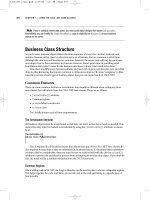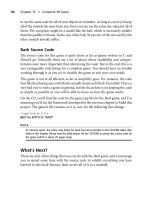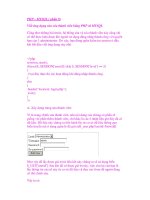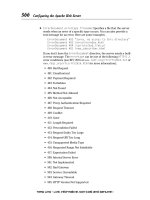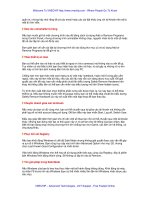cakephp application development phần 9 ppsx
Bạn đang xem bản rút gọn của tài liệu. Xem và tải ngay bản đầy đủ của tài liệu tại đây (3.66 MB, 33 trang )
Quickwall: User Authentication
[ 248 ]
6. Since an answer can have only one answerer, the Answer model has
belongsTo relationship with the User model. The Answer model already has
belongsTo relationship dened with the Question model. Hence, we modify
the $belongsTo variable to add the relationship with the User model:
<?php
class Answer extends AppModel {
var $belongsTo = array(
'Question' => array(
'className' => 'Question'
),
'User' => array(
'className' => 'User'
)
);
}
?>
7. Lastly, since we do not have the answerer eld in the Answer model any
more, let's remove the validation rule for it. The new $validation array
should look like this:
<?php
class Answer extends AppModel {
var $validate = array(
'answer' => array(
'rule' => array('minLenght', 1),
'required' => true,
'allowEmpty' => false,
'message' => 'Answer cannot be empty'
)
);
}
?>
Simpo PDF Merge and Split Unregistered Version -
Chapter 10
[ 249 ]
What Just Happened?
We started this section by removing any test data that we had in the database. This
is because we are going to change the structure of the database and to make sure the
old data does not bring any inconsistency. Thanks to God, these are just test data.
If this was a working app with real data, this process for porting data from the old
structure to the new would have taken a considerable amount of work.
In step 2, we dropped the elds questioner and answerer from the questions and
answers table respectively. Instead, we add a new eld to both the tables named
user_id. Since we have a users table that stores user-specic data, it will be
redundant to store the name of users in the questions and answers table. Instead
we will use user_id as a foreign key to the users table.
In the remaining steps, we dened model relationships between the User model,
Question model, and the Answer model. Since a user can have many questions and
a question can only belong to one user (questioner), the User model has $hasMany
relation to Question model. And the Question model has $belongsTo relationship
with the User model. Likewise, since a user can answer many answers, but an answer
belongs to one user (answerer) only, the User model has a $hasMany relationship with
the Answer model. And the Answer model has $belongsTo relationship with the User
model.
We also made sure that we remove the validation rule that we dened for the
questioner eld in Question model. We also removed the validation rule for
answerer in the Answer model. No need to validate non-existent elds.
It is not a good idea to run the application now, since we have not yet made changes
in the controllers and views. It will surely result in some weird errors. So, be patient
and wait till we are done with the next two sections.
Integrating Authentication: Controllers
We continue our effort to integrate the User model and the authentication process
into our database. This section shows the changes that are required in the controllers:
Time for Action
1. Go into the directory /app and create a new le. Name the le
app_controller.php. Add the following code to it and save:
<?php
class AppController extends Controller {
}
?>
Simpo PDF Merge and Split Unregistered Version -
Quickwall: User Authentication
[ 250 ]
2. Now, add the Auth component to the newly created AppController class:
<?php
class AppController extends Controller {
var $components = array('Auth');
}
?>
3. Add the beforeFilter() function to the AppController class, with the
following code:
<?php
class AppController extends Controller {
var $components = array('Auth');
function beforeFilter(){
$this->Auth->loginRedirect = array('controller'
=> 'questions', 'action' => 'home');
$this->Auth->logoutRedirect = array('controller'
=> 'questions', 'action' => 'home');
$this->Auth->allow('signup', 'confirm', 'home', 'show');
$this->Auth->authorize = 'controller';
$this->Auth->userScope = array('User.confirmed' => '1');
$this->set('loggedIn', $this->Auth->user('id'));
}
}
?>
4. Add a new method to the AppController class named isAuthorized().
Add the following into this method:
<?php
class AppController extends Controller {
var $components = array('Auth');
function beforeFilter(){
}
function isAuthorized() {
return true;
}
}
?>
Simpo PDF Merge and Split Unregistered Version -
Chapter 10
[ 251 ]
5. Now, open the Users controller le, and remove the Auth component and
the beforeFilter() method from it. It should look as follows:
<?php
class UsersController extends AppController {
var $name = 'Users';
var $components = array('Email');
function signup(){
}
function confirm($user_id=null, $code=null) {
}
}
?>
6. Add two new actions to the Users controller called login() and logout().
They should have the following code:
<?php
class UsersController extends AppController {
function login() {
}
function logout() {
$this->Session->setFlash('Logout');
$this->redirect($this->Auth->logout());
}
}
?>
7. Now, open the Questions controller and modify the home() action with the
following highlighted code:
<?php
class QuestionsController extends AppController {
function home() {
if (!empty($this->data) && $this->Auth->user('id')) {
$this->data['Question']['user_id'] = $this->
Auth->user('id');
$this->Question->create();
Simpo PDF Merge and Split Unregistered Version -
Quickwall: User Authentication
[ 252 ]
if ($this->Question->save($this->data)) {
$this->Session->setFlash('Your Question has been added');
} else {
$this->Session->setFlash('The Question could not be
saved. Please, try again.');
}
}
$this->data = null;
$this->Question->recursive = 1;
$this->set('questions', $this->Question->find('all'));
}
function show( $id = null) {
}
}
?>
8. Modify the show() action of the Questions controller with the following:
<?php
class QuestionsController extends AppController {
function show( $id = null) {
if (!$id) {
$this->Session->setFlash('Invalid Question.');
$this->redirect(array('action'=>'home'));
}
if (!empty($this->data) && $this->Auth->user('id')) {
$this->data['Answer']['user_id'] = $this->
Auth->user('id');
$this->Answer->create();
if ($this->Answer->save($this->data)) {
$this->Session->setFlash('The Answer has been saved');
} else {
$this->Session->setFlash('The Answer could not be
saved. Please, try again.');
}
}
$this->data = null;
$this->Question->recursive = 2;
$this->set('question', $this->Question->read(null, $id));
}
}
?>
Simpo PDF Merge and Split Unregistered Version -
Chapter 10
[ 253 ]
What Just Happened?
We started this section by adding the AppController. As you already know, all
controllers extend the AppController. So if we need to add something that should
be dened in all the controllers, it is a very good idea to add it to the AppController.
We added the le app_controller.php in the /app/ directory. If this le is not
present, the default AppController is used that can be found in /cake/libs/
controller/app_controller.php. It is a good idea to add the AppController in
the app directory, instead of changing the cake library le.
In step 2, we added the Auth component to the AppController. Now, the Auth
component can be accessed and used in all the controllers that we have on
our application.
Next, we added the beforeFilter() function to the AppController. Now, before
executing any controller action code, the code inside the beforeFilter() function
will be execcuted. In the beforeFilter() function, we dene a few properties of the
Auth component.
$this->Auth->loginRedirect is used to tell the Auth component where to redirect
after a successful authentication. Likewise, $this->Auth->logoutRedirect tells it
where to redirect after a user logs out.
$this->Auth->allow() denes which actions do not need any authentication. We
included the home() and show() action of the Questions controller, along with the
signup() and confirm() actions of the Users controller.
$this->Auth->authorize denes the type of authentication that should be done. In
our case we use controller, which is the simplest form of authentication.
$this->Auth->userScope denes any condition that the user needs to full to log
in. We set $this->Auth->userScope to array('User.confirmed' => '1'). For
a user to log in, their record should have the conrmed eld equal to 1. Any user
who has not conrmed cannot log in. Lastly, we send a variable to the view that
will contain the id of the currently logged in user. We can get information about the
currently logged in user using $this->Auth->user(). It will return the value of
the eld specied in the parameter. If no parameters are passed, it will return all the
elds of the record of the currently logged in user. If no user is logged in the current
session, it returns null.
Next, we added a new function to the AppController named isAuthorized(). This
is needed for the Auth component to work properly. This can be used to run extra
logic after a user has successfully authenticated. Since we do not need any such logic,
we just include it to return true.
Simpo PDF Merge and Split Unregistered Version -
Quickwall: User Authentication
[ 254 ]
Since we have included the Auth component in the AppController, we do not need
to include it in the Users controller. Also, we removed the beforeFilter() from the
Users controller.
In the next step, we add two new actions to the Users controller: login() and
logout(). You will notice that the login() action is empty. Normally, it contains
code that checks the user name and password with the database, and logs in a user.
We do not need to include any such code, as this is done automatically by the Auth
component. In the logout() action, we save a logout message to the session, and tell
the Auth component to logout the currently logged in user. This is done by calling
$this->Auth->logout(). This function also returns the URL to redirect after logout.
So, we just feed it to the redirect() function of the controller.
Next, we change the home() and show() actions of the Questions controller. We
do not want people to add questions or answers without logging in. So, if a new
question or answer is submitted, we check whether the user is logged in using the
$this->Auth->user() function. To save the id of the questioner, we set $this-
>data['User']['user_id'] to the id of the logged in user.
Integrating Authentication: Views
In this section, we make the nal set of changes that are required in the view to
make the User model integrate with the whole app. Also, we will add a user menu
from where users can sign up, log in, or log out. Finally, we will have a working
authentication system for the application.
Time for Action
1. Let's add a user menu to the application, by adding the following into the
layout le at /app/views/layout/default.ctp:
<!DOCTYPE html PUBLIC "-//W3C//DTD XHTML 1.0 Strict//EN"
" /> <html xmlns=" xml:lang="en"
lang="en">
<head>
</head>
<body>
<div id="content">
<div id="user_menu">
|<?php e($html->link('Home', array('controller'
=> 'questions', 'action' => 'home'))); ?>|
<?php if($loggedIn): ?>
Simpo PDF Merge and Split Unregistered Version -
Chapter 10
[ 255 ]
<?php e($html->link('Logout', array('controller'
=> 'users', 'action' => 'logout'))); ?>|
<?php else: ?>
<?php e($html->link('Sign Up', array('controller'
=> 'users', 'action' => 'signup'))); ?>|
<?php e($html->link('Login', array('controller'
=> 'users', 'action' => 'login'))); ?>|
<?php endif; ?>
</div>
<h1><?php e($html->link('Quickwall', array('controller'
=> 'questions', 'action' => 'home'))); ?></h1>
</div>
</body>
</html>
2. Add the view le for the login() action of the Users controller. Create a le
named login.ctp in /app/views/users/. Add the following code into it
and save:
<h2>Log In To Quickwall</h2>
<?php
if ($session->check('Message.auth')):
$session->flash('auth');
endif;
?>
<?php e($form->create('User', array('action' => 'login')));?>
<fieldset>
<label for="UserUsername" class="usernamelabel"><span>
Your Name</span></label>
<?php e($form->text('username', array('class'
=> 'fullwidth'))); ?>
<label for="UserPassword" class="emaillabel"><span>Password
</span></label>
<?php e($form->password('password', array('class'
=> 'fullwidth'))); ?>
<?php e($form->submit('Login In', array('div' => false,
'class' => 'submitbutton'))); ?>
</fieldset>
<?php e($form->end()); ?>
Simpo PDF Merge and Split Unregistered Version -
Quickwall: User Authentication
[ 256 ]
3. Make the following modications to the view of the home() action of the
Questions controller:
<?php if($form->isFieldError('Question/question')) e("<div
class='message'>You haven't entered any question</div>"); ?>
<! the validation check for questioner removed >
<?php if($loggedIn): ?>
<?php e($form->create('Question', array('action'
=> 'home')));?>
<fieldset>
<label for="QuestionQuestion" class="questionlabel">
<span>Your Question</span></label>
<?php e($form->text('question', array('class' =>
'fullwidth'))); ?><span class="big">?</span>
<! Input for Questioner removed >
<?php e($form->submit('Post Your Question',
array('div' => false, 'class' => 'submitbutton'))); ?>
</fieldset>
<?php e($form->end()); ?>
<?php else: ?>
<p>To post a question, please login or signup.</p>
<?php endif; ?>
<?php if(empty($questions)): ?>
<p class="no_answer">No Questions yet. Be the first one to post
a Question!</p>
<?php else: ?>
<dl>
<?php foreach ($questions as $question): ?>
<dt><span><?php e($question['User']['username']);
?></span></dt>
<dd>
<?php e($html->link($question['Question']['question'].
'?', array('controller' => 'questions', 'action'
=> 'show', $question['Question']['id']))); ?>
<?php
$answer_count = count($question['Answer']);
if(!$answer_count)
e("(no answers yet)");
else if($answer_count == 1)
e("(1 answer)");
else
e("(".$answer_count." answers)");
?>
</dd>
<?php endforeach; ?>
</dl>
<?php endif; ?>
Simpo PDF Merge and Split Unregistered Version -
Chapter 10
[ 257 ]
4. In the view le of the show() action of the Questions controller, make the
following modications:
<?php if($form->isFieldError('Answer/answer')) e("<div
class='message'>You haven't entered the answer</div>"); ?>
<! the validation message check for answerer removed >
<h2><?php e($question['Question']['question']) ?>?</h2>
<div id="questioner"><div><span><?php e($question['User']
['username']) ?></span></div></div>
<?php if($loggedIn): ?>
<?php e($form->create('Answer', array('url' => array('controller'
=> 'questions', 'action' => 'show', $question
['Question']['id']))));?>
<fieldset>
<?php e($form->hidden('question_id', array('value'
=> $question['Question']['id']))); ?>
<label for="AnswerAnswer" class="questionlabel"><span>Your
Answer</span></label>
<?php e($form->text('answer', array('class'
=> 'fullwidth'))); ?><span class="big">!</span>
<! input for the answerer removed >
<?php e($form->submit('Post Your Answer', array('div'
=> false, 'class' => 'submitbutton'))); ?>
</fieldset>
<?php e($form->end()); ?>
<?php else: ?>
<p>To post an answer, please login or signup.</p>
<?php endif; ?>
<?php if(empty($question['Answer'])): ?>
<p class="no_answer">No Answers yet. Be the first one to
answer!</p>
<?php else: ?>
<dl>
<?php foreach($question['Answer'] as $answer) : ?>
<dt><span><?php e($answer['User']['username']); ?>
</span></dt>
<dd><?php e($answer['answer']); ?></dd>
<?php endforeach; ?>
</dl>
<?php endif; ?>
5. Before checking out the new login system, clear the cache. Go to the directory
/app/tmp/cache. We will nd three directories: models, persistent, and
views. Delete all the les in these directories.
Simpo PDF Merge and Split Unregistered Version -
Quickwall: User Authentication
[ 258 ]
6. In the user menu, when we click on the login button, we should see a login
form as shown:
What Just Happened?
We started this section, by adding a user menu. Since we want this menu to be
available in all the pages, we added the menu in the layout le in /app/views/
layouts/default.ctp.
In step 2, we added the view for the login() action of the Users controller. This is
very similar to the signup() action view, but this view only has the user name and
password input. Make sure the form in login() view is submitted to the login()
action on the Users controller. In the view, we also check if the Auth controller has
set any message in the session.
In the next step, we modify the view of the home() action of the Questions
controller. If the user is not logged in, we will not show the question submit form.
Also, the input for questioner is removed, as we do not need it any more. Also, we
change the array from where the user name for questioner will be printed.
Similarly, we make changes to the show() action's view too.
Simpo PDF Merge and Split Unregistered Version -
Chapter 10
[ 259 ]
Well, nally we have a working authentication system. It might look like a lot of
work, but if see we only added a few lines of code to get a working authentication
system. But, we are still not happy with it. As you will see, in the next section, we
will add functionality for auto login if the user preferred to remember him.
Remembering User with Cookie
This is a feature that we see commonly in many websites. During log in, if the user
prefers to remember his credentials, and next time when the user goes to the site, he
is automatically logged in. Of course this is done using cookies.
In this section, we will also introduce the Cookie component. It helps to easily
read and write from cookies, but the good work does not end there. The Cookie
component automatically encrypts the data in the cookie, adding security to it.
Time for Action
1. Add the following code to the view of the Users Controller's login() action:
<h2>Log In To Quickwall</h2>
<?php
if ($session->check('Message.auth')):
$session->flash('auth');
endif;
?>
<?php e($form->create('User', array('url' => 'login')));?>
<fieldset>
<label for="UserUsername" class="usernamelabel"><span>
Your Name</span></label>
<?php e($form->text('username', array('class'
=> 'fullwidth'))); ?>
<label for="UserPassword" class="emaillabel"><span>Password
</span></label>
<?php e($form->password('password', array('class'
=> 'fullwidth'))); ?>
<label for="UserRememberMe" class="passwordlabel"><span>
Remember Me</span></label>
<p><?php e($form->checkbox('remember_me', array('class'
=> 'bigcheck'))) ?></p>
<?php e($form->submit('Login In', array('div' => false,
'class' => 'loginbutton'))); ?>
</fieldset>
<?php e($form->end()); ?>
Simpo PDF Merge and Split Unregistered Version -
Quickwall: User Authentication
[ 260 ]
2. Add the Cookie Component to the AppController class we created in /app:
<?php
class AppController extends Controller {
var $components = array('Auth', 'Cookie');
function beforeFilter(){
}
}
?>
3. Add the following two lines at the end of the beforeFilter() method in
AppController:
<?php
class AppController extends Controller {
function beforeFilter(){
//$this->Auth->loginAction = array('controller'
=> 'users', 'action' => 'login');
$this->Auth->loginRedirect = array('controller'
=> 'questions', 'action' => 'home');
$this->Auth->logoutRedirect = array('controller'
=> 'questions', 'action' => 'home');
$this->Auth->allow('signup', 'confirm', 'home', 'show');
$this->Auth->authorize = 'controller';
$this->Auth->userScope = array('User.confirmed' => '1');
$this->set('loggedIn', $this->Auth->user('id'));
$this->Auth->autoRedirect = false;
$this->Cookie->name = 'QuickWall';
}
}
?>
4. Open the Users controller le, and add the following code into the
login() action:
<?php
class UsersController extends AppController {
function signup(){
Simpo PDF Merge and Split Unregistered Version -
Chapter 10
[ 261 ]
}
function confirm($user_id=null, $code=null) {
}
function login() {
if ($this->Auth->user()) {
if (!empty($this->data)) {
if (empty($this->data['User']['remember_me'])) {
$this->Cookie->del('User');
} else {
$cookie = array();
$cookie['username'] = $this->data['User']
['username'];
$cookie['password'] = $this->data['User']
['password'];
$this->Cookie->write('User', $cookie, true,
'+2 weeks');
}
unset($this->data['User']['remember_me']);
}
$this->redirect($this->Auth->redirect());
}
}
function logout() {
}
}
?>
5. Now move back to the AppController, and add the following code to the
end of the beforeFilter() method:
<?php
class AppController extends Controller {
var $components = array('Auth', 'Cookie');
function beforeFilter(){
//$this->Auth->loginAction = array('controller'
=> 'users', 'action' => 'login');
$this->Auth->loginRedirect = array('controller'
=> 'questions', 'action' => 'home');
$this->Auth->logoutRedirect = array('controller'
=> 'questions', 'action' => 'home');
Simpo PDF Merge and Split Unregistered Version -
Quickwall: User Authentication
[ 262 ]
$this->Auth->allow('signup', 'confirm', 'home', 'show');
$this->Auth->authorize = 'controller';
$this->Auth->userScope = array('User.confirmed' => '1');
$this->set('loggedIn', $this->Auth->user('id'));
$this->Auth->autoRedirect = false;
$this->Cookie->name = 'QuickWall';
if(!$this->Auth->user('id')) {
$cookie = $this->Cookie->read('User');
if($cookie) {
$this->Auth->login($cookie);
}
}
}
function isAuthorized() {
return true;
}
}
?>
6. To make sure the cookie is deleted once the user prefers to log out, add the
following code to logout() action of the Users controller:
function logout() {
$cookie = $this->Cookie->read('User');
if($cookie)
$this->Cookie->del('User');
$this->Session->setFlash('Logout');
$this->redirect($this->Auth->logout());
}
7. When we go to the login page now, notice the remember me option:
Simpo PDF Merge and Split Unregistered Version -
Chapter 10
[ 263 ]
What Just Happened?
The rst thing that we did was add a checkbox to the login form. If this checkbox is
selected, then it shows that the user is interested to make him remember.
Next, we add the Cookie component to the AppController. In that way, all the
controllers can now access the Cookie component.
In the next step, we added two lines to the beforeFilter() function of the
AppController. The rst one is a property for the Auth component: $this-
>Auth->autoRedirect. We set it to false. By default this is set to true. In that case,
whenever a user successfully authenticates to the Auth component, it redirects to
the page specied by $this->Auth->loginRedirect. By setting $this->Auth-
>autoRedirect to false, the Auth component will return to the login() action after
successful authentication. The other line that we include sets the name of the cookie
to be set.
Next, we add code to the login() action. Once a user successfully authenticates, the
login() action is executed as $this->Auth->autoRedirect is set to false. Here,
if the user is authenticated and $this->data is not empty, it checks for the value
of $this->data['User']['remember_me']. It is selected, then a cookie is set, that
contains the username and password of the user. Normally, it is not a good idea to
store passwords in cookies. But, since the Cookie component encrypts the data, it is
not a too bad idea. After the cookie is set, the page is redirected to the default redirect
page of the Auth component.
Finally, we add code in the beforeFilter() of the AppController that checks
the following. First, it checks if the current session has a logged in user. If not,
then it checks for the cookie. If it nds a cookie, it sends the cookie data to $this-
>Auth->login() for authentication. If authentication succeeds, then the user is
automatically logged in.
Simpo PDF Merge and Split Unregistered Version -
Quickwall: User Authentication
[ 264 ]
Summary
In this chapter, we saw how to create proper user authentication with CakePHP. We
started the chapter by adding the User model that is central to the authentication
process. We then created a Sign-up process by which users can register to the site.
We enhanced the Sign-up process by adding Email conrmation to it. We then
moved on to integrate the User model with the other models. We added login and
logout processes to the site. At the end of the chapter, we added functionality to
remember a user so that he is automatically logged in, if he prefers to.
In more technical terms, this chapter showed us the use of three very important
components: Auth, Email, and Cookie component. We saw, how these components
can make it so easy to do things that take more time and effort if it was using raw
PHP coding.
By the end of this chapter, our Quickwall application has grown into a usable site,
where users can not only ask and answer questions, but they things also sign up and
log in to it. This was a very important feature to add, as we can make the site more
social, based on the authentication process.
Simpo PDF Merge and Split Unregistered Version -
Quickwall: JavaScript
and AJAX
In a time, not so long ago, all a back-end programmer needed to know was how
to fetch data from the database, control the logic, and have a good idea about the
back-end language used. Fast-forward to present, and all that has changed! A good
web programmer needs to be not only good with back-end programming, but also
has to have a good idea of front-end technologies like JavaScript.
In this chapter, we are going to see how to use JavaScript and AJAX with CakePHP.
We are going to add a bit of interactivity to Quickwall, and you will nd out how
easy it is (I know it may sound like a cliché, but fortunately it's true) to add AJAX to
Cake Applications.
In this chapter, we are going to:
Add JavaScript validation
Make AJAX call to update page
Add AJAX auto-complete to pull data from the database
Submit a form through an AJAX call
See how to add in-line editing that changes data with an AJAX call
Adding JavaScript Validation
In this section, we will see how to add JavaScript to a page in CakePHP. To make
it easier to manage and work with JavaScript, CakePHP has a built-in helper that
is known as the JavaScript helper. We are going to add a simple JavaScript to the
main page of Quickwall, so that if users submit a new question that is empty, it
instantly shows an error notication. This section will also see the usage of the
Prototype JavaScript Framework ( Some functions of
the JavaScript helper, and most of the AJAX helper (we will soon discuss this) uses
the Prototype library.
•
•
•
•
•
Simpo PDF Merge and Split Unregistered Version -
Quickwall: JavaScript and AJAX
[ 266 ]
Time for Action
1. In our layout le (/app/views/layout/default.ctp), add the following
line inside the <head> tag:
<!DOCTYPE html PUBLIC "-//W3C//DTD XHTML 1.0 Strict//EN"
" /> <html xmlns=" xml:lang="en"
lang="en">
<head>
<meta content="text/html; charset=utf-8" http-equiv=
"Content-Type"/>
title>Quick Wall</title>
<?php e($scripts_for_layout); ?>
<?php e($html->css('quickwall')); ?>
<! [if IE 6]>
<?php e($html->css('quickwall_ie6hack')); ?>
<![endif] >
</head>
<body>
</body>
</html>
2. Next, we will add the JavaScript helper in our AppController class (/app/
app_controller.php). We will also include the HTML and Form helper here:
<?php
class AppController extends Controller {
var $components = array('Auth', 'Cookie');
var $helpers = array('Html', 'Form', 'Javascript');
function beforeFilter(){
}
function isAuthorized() {
return true;
}
}
?>
3. We will be using Prototype, which is a JavaScript library. The version of
Prototype that we are using in this book is 1.6.0.2. So next, let us download
the library from the Prototype website: />4. Put the downloaded le into the following directory: /app/webroot/js. The
le name of the library should be prototype-1.6.0.2.js.
Simpo PDF Merge and Split Unregistered Version -
Chapter 11
[ 267 ]
5. Next, let us use the JavaScript helper to include the Prototype library into all
the pages. This is done by adding the following line in our layout le:
<!DOCTYPE html PUBLIC "-//W3C//DTD XHTML 1.0 Strict//EN"
" /> <html xmlns=" xml:lang="en"
lang="en">
<head>
<meta content="text/html; charset=utf-8" http-equiv=
"Content-Type"/>
<title>Quick Wall</title>
<?php e($javascript->link('prototype-1.6.0.2')); ?>
<?php e($scripts_for_layout); ?>
<?php e($html->css('quickwall')); ?>
<! [if IE 6]>
<?php e($html->css('quickwall_ie6hack')); ?>
<![endif] >
</head>
<body>
</body>
</html>
6. Also add a <div> into the layout le:
<!DOCTYPE html PUBLIC "-//W3C//DTD XHTML 1.0 Strict//EN"
" /> <html xmlns=" xml:lang="en"
lang="en">
<body>
<div id="content">
<div id="user_menu">
</div>
<h1><?php e($html->link('Quickwall', '/')); ?></h1>
<p id="strapline"><strong>"</strong>Quick way to Ask and
Answer<strong>"</strong></p>
<div id='js_errors' class='message' style='display:none'>
</div>
<?php
if ($session->check('Message.flash')):
$session->flash();
endif;
?>
<?php e($content_for_layout); ?>
</div>
</body>
</html>
Simpo PDF Merge and Split Unregistered Version -
Quickwall: JavaScript and AJAX
[ 268 ]
7. Create a new le in the directory /app/webroo/js, and name it home.js.
Add the following code to the le and save it:
Event.observe(window, 'DOMContentLoaded', function() {
Event.observe('QuestionHomeForm', 'submit',
checkQuestionNotEmpty);
});
function checkQuestionNotEmpty(event) {
if($F('QuestionQuestion') == '') {
Event.stop(event);
$('js_errors').innerHTML = "Cannot Enter Empty Question";
$('js_errors').show();
$('QuestionQuestion').focus();
}
}
8. Next, we would like to include the newly created JavaScript le in our
homepage. In the le /app/views/questions/home.ctp, add the
following line:
<?php e($javascript->link('home', false)); ?>
9. Now, to check if the JavaScript is working, point the web browser to
http://localhost/quickwall/, log in and try to submit an empty
question. We should see an error message as shown:
Simpo PDF Merge and Split Unregistered Version -
Chapter 11
[ 269 ]
What Just Happened?
In step 1, we added the line <?php e($scripts_for_layout); ?> in our layout
le. This is similar to <?php e($content_for_layout); ?>. But whereas
<?php e($content_for_layout); ?> is replaced by the view content, <?php
e($scripts_for_layout); ?> is replaced by any JavaScript link present in the
view. Since, we want all the JavaScript link to appear in the <head> tag, we insert
<?php e($scripts_for_layout); ?> inside the <head> tag.
In step 2, we added the JavaScript helper in our AppController. We are adding it
in the AppController, so that it is available in all the controllers in our application.
Another thing to note here is that we also added the HTML and Form helper to
the AppController. Normally, the HTML and the Form helper are loaded in the
controller by default. But, if any helper is added in the AppController, these are
overridden. So, it's a good idea to include the HTML and Form helper with any other
helper in the AppController.
In step 3, we download the Prototype Library. The version that we are using in this
book is 1.6.0.2. As you might already know, Prototype is a very popular JavaScript
library. It is a rich library with many useful features that help in making AJAX calls,
simplify event handling, and traversing DOM elements. Of course, there are many
more JavaScript libraries out there. But the reason we are using Prototype here, is
because CakePHP's JavaScript helper (part of it, to be exact) and AJAX helper
use Prototype.
In step 4, we copied the prototype-1.6.0.2.js le in the directory /app/webroot/js.
This is the directory where all JavaScript les for CakePHP applications are placed.
For easy managing, we can place related JavaScript les in directories under
this directory.
In step 5, we add the line <?php e($javascript->link('prototype-1.6.0.2'));
?> in our layout le. Here, we are using the JavaScript helper to create a link to
the Prototype library le. The link() function of the JavaScript helper returns a
<script> tag with links to the specied le. For example, the line above will output
the following line:
<script type="text/javascript" src="/quickwall_svn/js/prototype-
1.6.0.2.js"></script>
Also note that we do not need to include the extension of the JavaScript le.
Next, in step 6, we add a new <div> to the layout le. This <div>, with id='js_
errors', will be used to display the error message. Initially it is kept hidden by
using the attribute, style='display:none'.
Simpo PDF Merge and Split Unregistered Version -
Quickwall: JavaScript and AJAX
[ 270 ]
In step 7, we create a new JavaScript le in /app/webroot/js that we name home.
js. Of course, we could have named it anything we wanted. But since we will be
linking it to the home() action, we name it similarly. Now let's have a look at the
code inside home.js. The JavaScript code extensively uses the Prototype library.
Though explaining the JavaScript code is beyond the scope of this book, here is
a general overview of the code. When the DOM has been loaded, it attaches an
event to the form with id = "QuestionHomeForm". This is the form present in the
homepage, which is used to input a new question. The event attaches the function
checkQuestionNotEmpty(), so that it is executed whenever the form is submitted.
In this function, it is checked whether the question submitted is empty. If so, then it
stops the event (submitting of the form), and adds an error message in the <div> we
added earlier. Lastly, it gets the focus back to the question input text.
Next, in step 8, we added <?php e($javascript->link('home', false)); ?>
to link the JavaScript le we just created to the view of the home() action of the
Questions controller. We again use the JavaScript helper's link() function to
create a <script> tag. We also added a second parameter false. This attaches
the JavaScript link to where <?php e($scripts_for_layout); ?> is situated. By
default, the second parameter is true. In that case, the <script> tag is included in
the view where the call to $javascript->link() is made.
AJAX Link to Show Own Questions
Here, we will be using the AJAX helper of CakePHP to make AJAX calls. The AJAX
helper uses the Prototype library to produce different JavaScript functionalities.
Basically, the AJAX helper is a CakePHP wrapper for Prototype, so that CakePHP
developers can easily deploy different JavaScript functionalities without knowing
JavaScript at all!
In this section, we will add a new page to the application, the search page. For the
time being, this page will only contain a link called Show My Questions. When
clicked, an AJAX call will be made to the server, and fetch all your questions. The
main idea here is to see how to make a successful AJAX call using the AJAX helper.
Time for Action
1. We will start by adding a new action to the Questions controller. We name
the action search():
<?php
class QuestionsController extends AppController {
var $name = 'Questions';
var $uses = array('Question', 'Answer');
function home() {
Simpo PDF Merge and Split Unregistered Version -
Chapter 11
[ 271 ]
}
function show( $id = null) {
}
function search() {
}
}
?>
2. Next, we add the view le for this action. Create a new le in /app/views/
questions/ and name it search.ctp.
3. We will be using the AJAX helper for this task. So, lets add the helper in our
AppController (/app/app_controller.php):
<?php
class AppController extends Controller {
var $components = array('Auth', 'Cookie');
var $helpers = array('Html', 'Form', 'Javascript', 'AJAX');
}
?>
4. In the view of the search() action, add the following lines:
|<?php e($ajax->link(
'Show Your Questions',
array('controller' => 'questions', 'action' =>
'user_questions', $loggedIn),
array('update' => 'questionList', 'loading' => "$('loader').
show()", 'loaded' => "$('loader').hide()")
)); ?>|
<div id="questionList"></div>
5. The above will create a link that will make an AJAX call to Questions
controller's user_questions action. Let us create the user_questions, and
add the following code to it:
<?php
class QuestionsController extends AppController {
var $name = 'Questions';
var $uses = array('Question', 'Answer');
function home() {
Simpo PDF Merge and Split Unregistered Version -
Quickwall: JavaScript and AJAX
[ 272 ]
}
function show( $id = null) {
}
function search() {
}
function user_questions($user_id = null) {
$this->layout = 'ajax';
Configure::write('debug', '0');
$this->set('questions', $this->Question->find('all',
array('conditions' => array('user_id' => $user_id))));
}
}
?>
6. To reuse code, we will now create an element. Inside the directory /app/
views/elements, create a new le named question_list.ctp. Add the
following code to the le and save it:
<dl>
<?php foreach ($questions as $question): ?>
<dt><span><?php e($question['User']['username']); ?>
</span></dt>
<dd>
<?php e($html->link($question['Question']['question'].'?',
array('controller' => 'questions', 'action'
=> 'show', $question['Question']['id']))); ?>
<?php
$answer_count = count($question['Answer']);
if(!$answer_count)
e("(no answers yet)");
else if($answer_count == 1)
e("(1 answer)");
else
e("(".$answer_count." answers)");
?>
</dd>
<?php endforeach; ?>
</dl>
Simpo PDF Merge and Split Unregistered Version -


